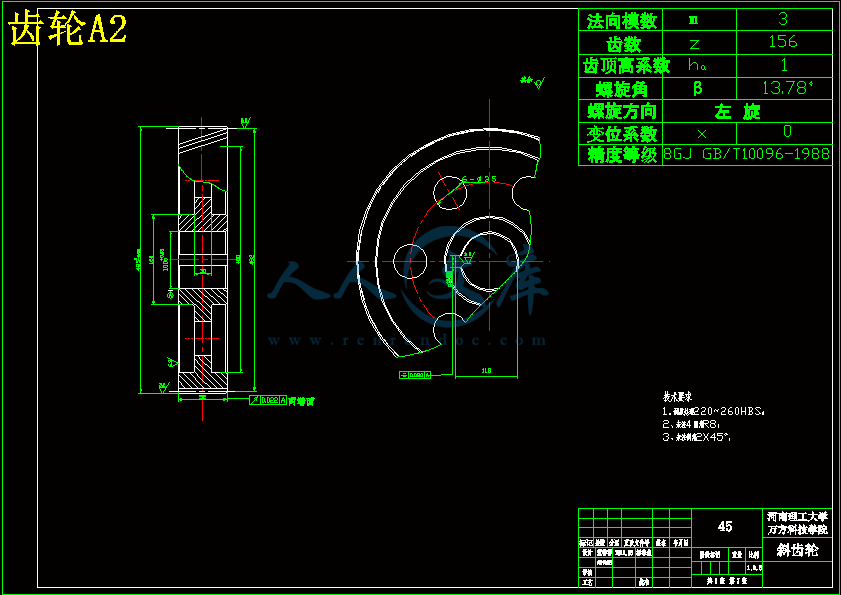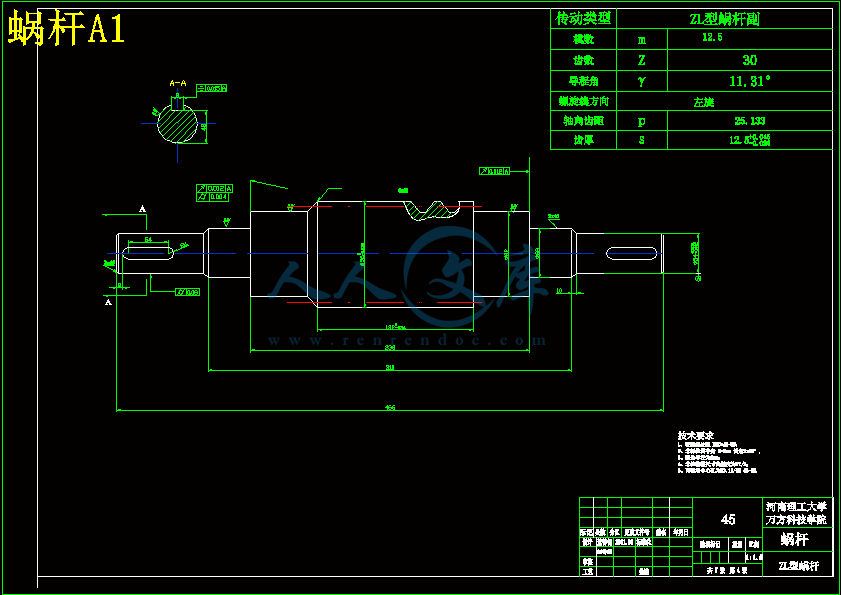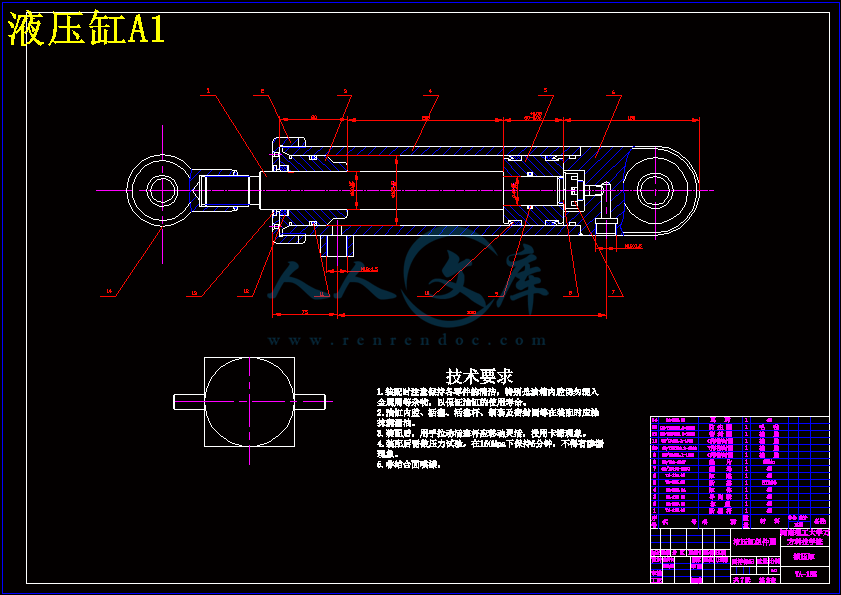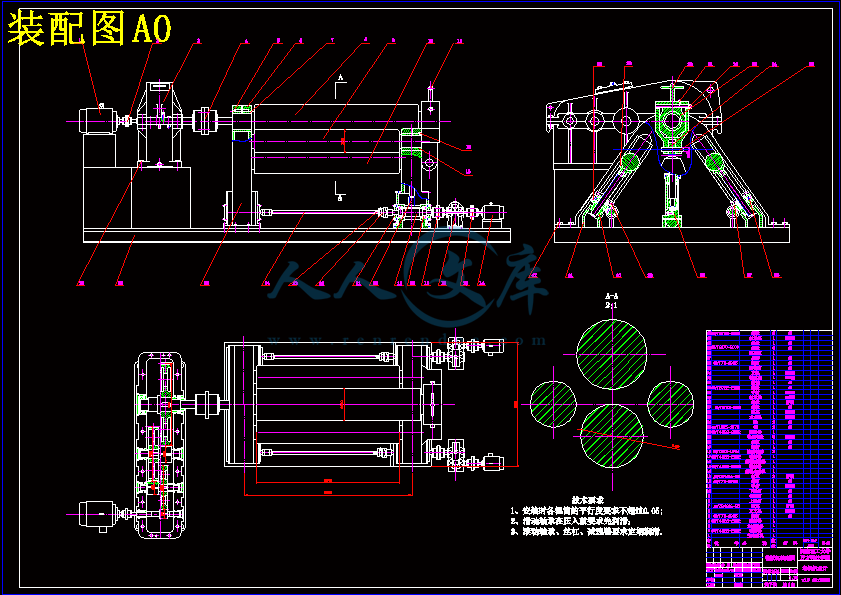W12X2000型四辊卷板机设计
60页 12000字数+说明书+外文翻译+7张CAD图纸【详情如下】
减速器A1.dwg
W12X2000型四辊卷板机设计论文.doc
外文翻译--刀具成本的检测.doc
液压缸A1.dwg
端盖A3.dwg
蜗杆A1.dwg
装配图A0.dwg
齿轮A2.dwg
齿轮轴A2.dwg
摘 要
本说明书是按照所设计的卷板机内容撰写的,主要包括卷板机轴辊的受力分析、电动机的选择、主减速器的设计、侧辊传动系统的设计、下辊液压传动系统的设计以及对下辊液压同步控制系统进行了研究。从而保证了下辊在上升的过程中始终能够保持两端同步。
四辊卷板机主要为锅炉厂辊制锅炉圆筒而设计,它可以用于各种型号锅炉圆筒的生产和加工,也在造船、石油化工、航空、水电、装潢、及电机制造等工业领域得到了广泛的应用,用以把金属板料卷制成圆筒、圆锥以及弧形板等各种零件。
该四辊卷板机利用其四个辊筒的空间布置,最大范围地减少了剩余直边的出现、降低了生产成本、提高了生产效率。
关键词:四辊卷板机 辊制 剩余直边 弧形板
Abstract
This statement is in accordance with the design cylinder content written mainly include the pressure analysis of cylinder axle roller, electric motors choice, the reducer design, lateral roller drive train system design, the design of the roller hydraulic drive train system on the roller and hydraulic control systems simultaneously conducted research. Thereby ensuring an increase in the course of the roller always able to maintain both simultaneously.
The four cylinder roller machine mainly boiler plant roller system designed boilers cones, which can be used for various types of boilers cones production and processing are also shipbuilding, petrochemical, aviation, utilities, furniture, and electrical manufacturing industries widely applied to the metal plate material volumes produced cones, circular cone arc boards and various parts.
The four cylinder roller machine use its four roller cylinders space layout, the greatest scope to reduce the margin in the remaining departments, reducing production costs, improving production efficiency.
Key words: four-cylinder roller machine Roller machineLeft straight-side Arc board
目 录
前 言1
第1章 绪 论2
1.1卷板的分类及特点2
1.2卷板机的分类及特点2
1.3 W12X2000型四辊卷板机的用途5
1.4 传动系统设计6
第2章 卷板机轴辊受力分析7
2.1作用在卷板机辊子上的弯曲扭矩7
2.2卷板机的空载扭矩8
2.3四辊卷板机的卷板力8
第3章 电动机的选择与计算12
3.1功率计算12
3.2电动机的选择12
第4章 主减速器的设计14
4.1电动机的确定14
4.2 传动比的分配15
4.3传动系统的运动和动力参数设计15
4.4 高速级斜齿圆柱齿轮传动的设计计算17
4.4.1选择精度等级,材料和齿数17
4.4.2 按齿面接触强度设计17
4.4.3按齿根弯曲疲劳强度设计21
4.4.4几何尺寸计算21
4.5中间级斜齿圆柱齿轮传动的设计计算22
4.5.1选择精度等级,材料和齿数22
4.5.2. 按齿面接触强度设计22
4.5.3.按齿根弯曲疲劳强度设计24
4.5.4几何尺寸计算26
4.6 低速级斜齿圆柱齿轮传动的设计计算:26
4.6.1选择精度等级,材料和齿数26
4.6.2. 按齿面接触强度设计27
4.6.3按齿根弯曲疲劳强度设计29
4.6.4几何尺寸计算30
4.7高速轴的设计以及轴的校核32
第5章 侧辊传动系统的设计36
5.1侧辊电动机的确定36
5.2侧辊减速器的确定36
5.3蜗轮蜗杆传动设计36
第6章 下辊筒液压缸的设计41
6.1下辊液压系统的工作原理41
6.2下辊筒液压缸设计42
第7章 辊筒轴的强度校核47
第8章 专题论文50
8.1前言50
8.2四辊卷板机工作原理50
8.3液压同步控制系统研究及设计原理52
8.4.结论53
致 谢54
参考文献55
我所设计的这台四辊卷板机由四个辊筒所组成,其中一个上辊、两个侧辊和一个下辊。最大可以将40mm厚、2m长的钢板卷曲成圆柱、圆锥或其一部分。
上辊为主传动,由主电动机通过主减速器和联轴器与上辊筒相连接,为卷制钢板提供扭矩;下辊作垂直升降运动,通过液压缸内的液压油作用于活塞而获得,以便夹紧板材,为液压传动,在下辊的两侧设有两个侧辊,侧辊可以沿着机架导轨做倾斜运动,由侧辊电动机通过一个单级减速器把扭矩传到丝杆丝母蜗轮蜗杆传动副,这样既达到了传递扭矩的作用,同时也改变了运动方向。
在本次设计中,我设计了一套液压同步控制系统,通过控制电磁换向阀的通断,来控制下辊两端液压缸的同步上升,达到在下辊上升的过程中,下辊中心线能够始终同上辊中心线保持水平,这样就可以避免因钢板位置偏离中间位置,而使下辊受力不均匀,使下辊在上升的过程中一端受力大,一端受力小,使卷出来的圆筒一端大而一端小的情况发生。
本次毕业设计是一次大型综合的设 计,通过这次做毕业设计使我对大学四年所学的知识有了更加深刻的回顾,也培养了我使用工具书的能力,同时它也是对我大学四年所学知识的一次检验。通过做毕业设计使我学习到了许多在课本上面所学习不到的致知识,也提高了我的动手能力。相信他们都是我在未来工作中能够用得上的。第1章 绪 论
近些年随着原子能、石油化工、海洋开发、宇航、军工等部门的迅速发展,卷板机作业的范围正在不断的扩大,要求也在不断提高,现在卷板机已经广泛应用于锅炉、造船、石油化工、航空、水电、装潢、金属结构等行业中,用于将金属板材卷制成圆柱、圆锥或者将任意形状卷曲成圆柱形或其一部分。
1.1卷板的分类及特点
卷板按照工作状况分为:冷卷和热卷两种。冷卷的精度高,操作方便,要求钢板不能有缺口及裂缝等缺陷,有时还需在滚弯前进行正火或退火处理。热卷的最大缺陷是产生氧化皮及明显热膨胀。因此,只有当弯制的板超过机器的冷卷能力或弯曲较大时,才能使用热卷法,但冷卷的板料厚度范围目前正在日益扩大。生产也应根据不同卷制方法的特点结合具体情况适当选用。例如有些不允许冷卷的刚度太差,而且弯曲困难。如果采用温卷的方法就比较合适。
1.2卷板机的分类及特点
卷板机按照辊筒数量布置形式分为:四辊式卷板机和三辊式卷板机,其中三辊又可以分为对称式和不对称式两种。对称式三辊卷板机:结构紧凑,重量轻,易于制造、维修,投资小,两侧辊可以作得很近,成形准确。但是剩余直边大,一般对称三辊卷板机减小剩余直边比较麻烦。(如图1.1-2所示)
不对称三辊卷板机是一根下辊轴和上辊轴中心水平距离到极小位置,另一根下辊轴放在侧边,所以滚出的零件仅起始端有直边。这样在滚零件时,正反两次辊制就可以消除直边问题。(如图1.1-1所示)其缺点为:在滚弯时大大增加了辊轴的弯曲力,使辊轴容易弯曲,影响零件的精度,坯料需要调头,弯边,操作不方便,辊筒受力较大,弯卷能力较小。
图1.1-1非对称式卷板机 图1.1-2对称式卷板机
卷板机按辊位调节方式可以分为:上调式和下调式两种,其中上调式可以分为横竖上调式(机械或液压调节);垂直上调式;下调式又可以分为不对称下调式(机械或液压调节);对称下调式(含垂直下调式)(液压调节)水平下调式(液压调节)。
垂直下调式:结构简单、紧凑;剩余直边小,有时设计成上辊可以沿轴向抽出的结构。它的缺点是:弯板时,板料有倾斜动作,对热卷及重型工件不安全,长坯料必须先经初弯,否则会碰地面。
水平下调式:较四辊卷板机的结构紧凑,操作方便剩余直边小,坯料始终保持在同一水平面,进料安全方便。其缺点是:上辊轴承间距较大,坯料对中不如四辊卷板机方便。
横竖上调式:如图1.1-3,调节辊筒的数目最少,具有各种三辊的优点,而且剩余直边小。其缺点:设计时结构复杂不易处理。 卷板机按照辊筒方位,可以分为立式和卧式。按上辊受力类型,可以分为闭式(上辊中部有托辊)和开式(上辊无中部托辊),其中开式又可以分为有反压力装置的和无反压力装置的。
立式:如图1.1-4,消除了氧化皮压伤,矩形板料可保证垂直进入辊间,防止扭斜,卷薄壁大直径,长条料等刚性较差的工件时,没有因自重而下榻的现象,板样测量较准,占地面积小。其缺点是:短工件只能在辊筒下部卷制,辊筒受力不均匀,易呈锥形;工件下端面与支撑面摩擦影响上下曲率的均匀性,卸料及工件放平料不方便,非矩形坯料支持不稳定。
闭式:如图1.1-5 没有活动轴承机构结构较简单,上辊加中间支承辊后可作得很细可弯到较大的曲率,上辊刚度好,工件母线直线度好,下辊间距小,可卷薄板且曲率较准确,上辊行程大,有足够的位置装模具,可以作长拆边机用,但只能卷制圆心角小于180度的弧形板。 四辊卷板机有四个辊,(如图1.1-6所示)上辊是主动辊,下辊可以上下移动,用以夹紧钢板,两个侧辊可以沿斜向升降,在四辊卷板机上可进行钢板的预弯工作,它靠下辊的上升,将钢板端头压紧在上下辊之间,再利用侧辊的移动使钢板端部发生弯曲变形,从而达到所要求的曲率。
它的优点是:
预弯及卷圆时,钢板可不调头。
上下辊能夹紧钢板,防止弯曲时滑脱。
侧辊能起定位作用,在进料时可使钢板找正。
4、便于弯曲锥形件,椭圆形件及仿形加工。
综合以上各种卷板机的综合特点,在本次毕业设计中我选择了W12 40X2000型四辊卷板机进行设计
1.3 W12X2000型四辊卷板机的用途
W12X2000型四辊卷板机是专供金属板的卷曲和弯曲圆筒之用,是锅炉、造船、石油化工、水泥、电机及电器制造业中的主要设备之一。在常温的情况下,它可以将长达2m,厚度达40mm的钢板弯曲成圆柱面、圆锥面或任意形状的柱面或其一部分,在加热的情况下,它可以将长达2m,厚度达70mm的钢板卷曲成圆柱形或其一部分,它可以对一些厚度大,用常规方法无法弯卷的钢板进行加工,在加工的过程中它还可以对金属板端部进行直接弯曲,免去了端部预弯的工序,这是四辊卷板机比一般三辊卷板机优越之处。因此,W12X2000型四辊卷板机在锅炉、造船、石油化工、水泥、电机及电器制造业中得到了广泛应用。同时,这种设备的上市大大减轻了工人的劳动强度,提高了企业的效益。 W12 40X2000型四辊卷板机是以上辊为主动辊,由主电动机通过主减速器及联轴器,从而带动上辊工作,下辊的作用是提供一定的向上力,(设该力为夹紧力W),与上辊一起夹紧所卷钢板,使上辊与被卷钢板间产生足够的摩擦力,在上辊旋转时能够带动钢板运动。两个侧辊用以形成卷筒所需的曲率,使板料达到所需的目的。
在我设计的这台四辊卷板机中,我采用了由主电动机通过主减速器以及联轴器,从而带动上辊的旋转。而下辊的运动我采用在下辊的两端各放一个液压缸,通过液压缸内的液压油作用于活塞而使下辊能够实现上下的升降运动,以便夹紧钢板,用液压系统来控制下辊筒的升降以及两个液压缸在上升的过程中保持同步上升。在下辊的两侧设有两个侧辊,两个侧辊分别由两个电动机通过两个单级减速器以及联轴器带动;两个电动机可以分别单独控制也可以同时控制,两个侧辊可以沿着机架导轨做倾斜运动,通过丝杆丝母蜗轮蜗杆传动。
参考文献
濮良贵,纪名刚主编. 机械设计(第七版).北京:高等教育出版社, 2002
垄桂义主编. 机械设计课程设计图册.北京: 高等教育出版社, 2000
沈兴全,吴秀玲主编. 液压传动与控制.北京: 国防工业出版社, 2005
黎启柏主编. 液压元件手册. 北京:机械工业出版社, 2000
任金泉主编. 机械设计课程设计. 陕西:西安交通大学出版社, 2003
刘品,刘丽华主编. 互换性与测量技术基础. 黑龙江:哈尔滨工业大学出版社, 2001
机械工程手册编委会主编. 机械工程手册(第7卷). 北京:机械工业出版社, 1982
机械设计手册编委会主编. 机械设计手册(第3卷).北京: 机械工业出版社, 2004
王宪军,赵存友主编. 液压传动. 黑龙江:哈尔滨工程大学出版社, 2002
赵铁主编. 液压四辊卷板机同步控制系统的研究与改进.河南: 焦作工学院学报,1996,6:(3)3338
王大川,沈利蓉主编. 卷板机轴辊的受载分析及板裁曲率半径的确定.山西: 山西煤炭.2002,12:(4)45-46
王青主编. 80X2800mm卷板机设计. 内蒙古:包钢科技. 1997(4):134-136
苏传德主编. 卷板机电机驱动功率的计算. 山东冶金. 1999,6(3):42-43
成其谦,吴荣昌主编. W12四辊卷板机改造. 制造与工艺. 2000,6(2):29-32
常英丽,刘晓涵主编. Z31900SM型四辊卷板机技术改进.2004,(7):101-102







 川公网安备: 51019002004831号
川公网安备: 51019002004831号